Konica Minolta DiMAGE A200
Review Date: February 3rd 2005
|
Ease of Use
The Konica Minolta DiMAGE A200 looks and feels on first impressions like a small digital SLR, with its 28-200mm lens that has a proper zoom ring on the lens barrel, a multitude of external switches and buttons (over 20 in total), external hotshoe (as well as the built-in pop-up flash) and a viewfinder that looks like a traditional optical viewfinder (but is actually electronic). If you have used a 35mm or digital SLR camera before, you will feel instantly at home with the Konica Minolta DiMAGE A200. If your previous experience is limited to a compact digital or film camera, then be prepared to read the manual thoroughly (PDF format only), as this is a complicated piece of equipment that has a steep operational learning curve.
The camera is on the whole very well built and designed, despite being made entirely of plastic. It's one of those cameras that is not too heavy as to be cumbersome, but not too light as to feel flimsy. It has a reassuring weight and feel that instantly made me like the camera, with a substantial hand-grip coated in a textured rubber material to aid handling, and a small area on the back of the camera where your thumb sits which is similarly coated. Everything fitted my large hand size very well.
The one thing that really made the Konica Minolta DiMAGE A200 great to use was the zoom ring on the lens. After using the various zoom button designs on countless compact digicams, being able to use a "proper" zooming mechanism that works in the same way as on a 35mm SLR lens is a breath of fresh air. I find it much more intuitive, quicker and more precise to use than zoom buttons, and for me personally this would be a big attraction of the Konica Minolta DiMAGE A200 if I were looking to buy a digital camera.
| Manual Zooming Ring / Macro Button | Anti-Shake Button |
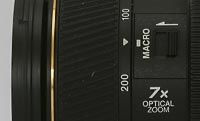 |
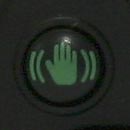 |
Having said that, the lens and the actual implementation of the zoom aren't particularly great, especially if you compare them to the usual high build quality and silky smooth action of a quality 35mm zoom lens. The Konica Minolta DiMAGE A200's lens body is made entirely of plastic and the zoom barrel feels a little bit sticky as you rotate it from wide-angle to telephoto and back again. This may get better as time passes and the lens "beds in", and I should remember that I am comparing an entire £450 digital camera with a £450 35mm SLR lens. Like everything the Konica Minolta DiMAGE A200 is built to a certain price-point - just be aware of this when you consider which kind of camera system to buy.
Having a zoom ring on the lens barrel encourages you to hold the camera up to your eye and look through the viewfinder, rather than use the LCD screen on the rear of the camera, much like using a digital SLR camera which doesn't have an LCD screen. Unlike a DSLR, the Konica Minolta DiMAGE A200 has an electronic viewfinder (EVF) instead of the more traditional optical version, and this is one aspect which lets the camera down slightly. Despite being equipped with dioptre control which allows you to fine-tune the display to your eyesight, and despite displaying lots of information in a clear way, I found the EVF to be both grainy and dim and not particularly comfortable to use - it doesn't compare well to a traditional optical viewfinder. This wouldn't be so much of an issue with most cameras that offer an EVF and LCD screen combination, because you could simply use the LCD screen instead (which is incidentally excellent on the Konica Minolta DiMAGE A200). The zoom ring, however, encourages you to hold the camera up to your eye and therefore use the EVF - holding it at arm's length and trying to focus just feels plain wrong. So one of the most attractive features of this camera, the zoom ring, inadvertently reveals one of its weaknesses, the EVF.
The other main selling point of the Konica Minolta DiMAGE A200 is its unique CCD-shift anti-shake mechanism, which is also implemented on the much more expensive Konica Minolta 7D DSLR camera. This allows you to take sharp photos at slower shutter speeds than other digital cameras, and it works really well - you can see the results for yourself on the next page. From an ease of use point of view, enabling this feature couldn't be easier - simply press the button with the green hand on the rear of the camera (just above the LCD screen). You don't notice that the camera is actually doing anything different when anti-shake is turned on, just that you can use slower shutter speeds than normal and still take sharp photos.
| Function Button / Control Dial and Button Exposure Compensation / White Balance Quick View/Delete Button / Menu Button |
Information Button Auto Exposure Lock Button |
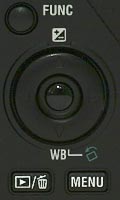 |
 |
As stated above, the Konica Minolta DiMAGE A200 has a large number of external buttons and switches on its body. If you have used a digital SLR camera before, then you will quickly find your way around the camera. There are 20 external controls in total, with most of them clearly labeled using industry-standard symbols and terminology. Despite all those controls, the camera body still feels well-designed and not too cluttered. If you have never used a digital camera before, or you're upgrading from a more basic model, reading the comprehensive and easy-to-follow manual before you start is essential (although it is only available in PDF format and not as hard-copy).
The menu system of the Konica Minolta DiMAGE A200 is confusing at first because of the way in which you access it. There are two buttons, the Func button and the Menu button, which allow you to access the majority of the camera's menu options - on most digicams there is only one button (typically the Menu button) which opens the menu system. Having a two button system means that you have to learn and remember which options are accessed by which button, a task that isn't helped by the unclear division. The Func button, for example, allows you to set ISO speed and Flash, whereas the Menu button allows you to set Image Size and Quality. I guess the Func button is home to the options that you will change most often (in the camera designer's opinion), but there is enough room in the menu system that is accessed by the Menu button, so I would have preferred to see all the menu options in one place.
The start-up time of the Konica Minolta DiMAGE A200, from turning the camera on to being ready to take a photo, is pretty quick at around 1 second, so you won't miss many shots whilst you're waiting for the camera to turn itself on. Having that great mechanical zoom ring means that zooming from the widest focal length to the longest is as quick as you can make it! It also has the side-benefit of not being very noisy, as the powered zooming mechanisms on some cameras are, although there is a small amount of noise due to the friction between the lens and the lens barrel as you zoom it in and out. Shutter-lag isn't too noticeable at around 0.25 seconds.
| Movie/Play/Camera Switch On/Off Button |
Exposure Mode Dial |
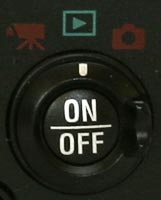 |
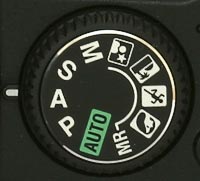 |
Focusing is very quick when using the Konica Minolta DiMAGE A200 outdoors in good light - unfortunately its not so great when trying to achieve focus indoors or in low-light situations. The camera doesn't have an AF assist light, which means that it typically hunts for something to lock on to for a few seconds and then gives up completely. This is especially true as you get nearer to the telephoto end of the zoom. There is a manual focus option that you can use instead, but if you are looking for a camera that will be able to capture your children playing indoors, for example, then the Konica Minolta DiMAGE A200 won't be for you.
Storing a JPEG image is instantaneous, but be prepared for a wait if you are using the RAW mode - the camera locks up for about 3 seconds after you press the shutter button, and you can't take another shot until it has finished recording the image. Continuous mode is is pretty rapid, allowing you to take up to 5 photos in approximately 3 seconds. High Speed Continuous is even quicker, delivering an impressive 5 shots in less than a second (at any image quality and size combination). The camera does lock up again for a couple of seconds, however, after a sequence of shots in both continuous modes. There is also an Ultra High Speed mode, but this only allows for 640x480 pixel images to be taken. All in all the Konica Minolta DiMAGE A200 is average in terms of operational speed and is best suited to use outdoors or in good lighting conditions.
Once you have captured a photo, the Konica Minolta DiMAGE A200 has a lot of options when it comes to playing, reviewing and managing your images. You can scroll through the images that you have taken, zoom in and out to a factor of x10 and play a slideshow. You can rotate images, choose which images to Lock (to prevent them from being deleted), and delete an image. You can configure which images you want to print, selecting whether to print the date, how many copies you want to print and if you want to make an index print. Making a copy of an image that you have taken is also possible, and you can select images that will be attached to an email when you download onto your computer. Importantly there is also a histogram to show the exposure of a recorded image, and you can also choose to display one whilst you are taking a photo. The display also flashes to indicate areas that are overexposed and have blown highlights - very handy.
Overall the Konica Minolta DiMAGE A200 is easy-to-use but is lacking in a few important areas, principally its speed in low-light situations.
|
 PhotographyBLOG is a member of the DIWA organisation. Our test results for the Konica Minolta DiMAGE A200 have been submitted to DIWA for comparison with test results for different samples of the same camera model supplied by other DIWA member sites.
PhotographyBLOG is a member of the DIWA organisation. Our test results for the Konica Minolta DiMAGE A200 have been submitted to DIWA for comparison with test results for different samples of the same camera model supplied by other DIWA member sites.
